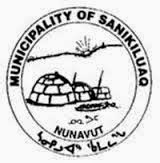 |
| Sanikiluaq across the 'Bay' |
Being the southernmost
community in all of Nunavut, it is only 150 kilometers (93 miles) from the
shores of NUNAVIK, Quebec. Not only is the community the most
southernly, it is also the most easterly of the Kivalliq region of NUNAVUT
located on the north coast of Flaherty Island in
Hudson Bay.
It is still the arctic there,
as no trees grow and temperatures are often very cold and accompanied by strong
winds. Located in the heart of Hudson Bay in the Belcher Islands, Sanikiluaq
is an Inuit community of some 850 residents. It
is the only permanent settlement in this entire archipelago, which is a group
of 1,500 islands spread over 3,000 square kilometres (1,158 square miles).
 |
| The Hamlet's Crest |
The terrain near Sanikiluaq
is composed of numerous rocky cliffs that tower to 155 metres (509 feet) above
sea level. Many of the smaller islands provide special breeding grounds
for numerous species of migratory seabirds, ducks and geese. The coastal waters
contain an abundance of seals, walruses and beluga whales. Expert hunting and
fishing is a traditional lifestyle here, as is sea kayaking and soapstone
carving.
 |
| The famous water truck supplying most hamlets in KIVALLIQ |
Robert Joseph Flaherty and his
crew arrived here on a prospecting expedition in 1913. They were the first
'qallunaat' ('people with low bushy eyebrows' — white people, in Inuktitut) to
winter here. Flaherty brought along a movie camera and later he became famous
for his documentary film titled 'Nanook of the North' (1922). The island
is, of course, named after him.
 |
| The fine art of Sanikiluaq |
 |
| Grass Basket Craftwork |
 |
| 5" Black Basking Walrus by Johnny Appaqaq - Inuit Carver |
The community of Sanikiluaq was created in 1971 when the federal government consolidated its services and relocated all the buildings and inhabitants of the southern settlement into the northern one. The economy is largely based on subsistence hunting, fishing, plus arts and crafts.
The
indigenous ancestors of the local Inuit people inhabited this area for many
centuries. They arrived there from the mainland region of northern Québec. As
evidenced by the numerous archaeological sites found scattered across the
archipelago, the ancient Dorset and Thule cultures both lived on these islands.
Dorset Culture ('Tuniit' or 'Sivullirmiut'): 500 BC to 1500 AD
Dorset Culture ('Tuniit' or 'Sivullirmiut'): 500 BC to 1500 AD
Thule
Culture (Proto-Inuit): 1000 AD to 1600 AD
Inuit
Culture (Eskimo): 1600 AD to present-day.
The
archipelago first came to the attention of European outsiders when the British
explorer Henry Hudson spotted these islands in 1610. After wintering further
south in James Bay, his crew mutinied in 1611. Cast adrift, Hudson and his son
were never seen again.
The natural resources of
Sanikiluaq owe much to its geographic location. As with many northern islands,
the weather is noteworthy for its sudden winter storms and dramatic drops in
temperature. Travellers to the island should take this into account.
 |
| The modern Inuit 'sport' |
At this point, I’m eagerly
awaiting the news this summer, of the exploration of one of Franklin’s missing
ships found in the past year. All Canadians should be proud of the people of the
north. They, too, are proud Canadians and their contributions to our culture are
reflected when you look at the art, the crafts, the music and, from what
appears to be here in the north, the 2 favourite past times…Bingo and…Hockey.


